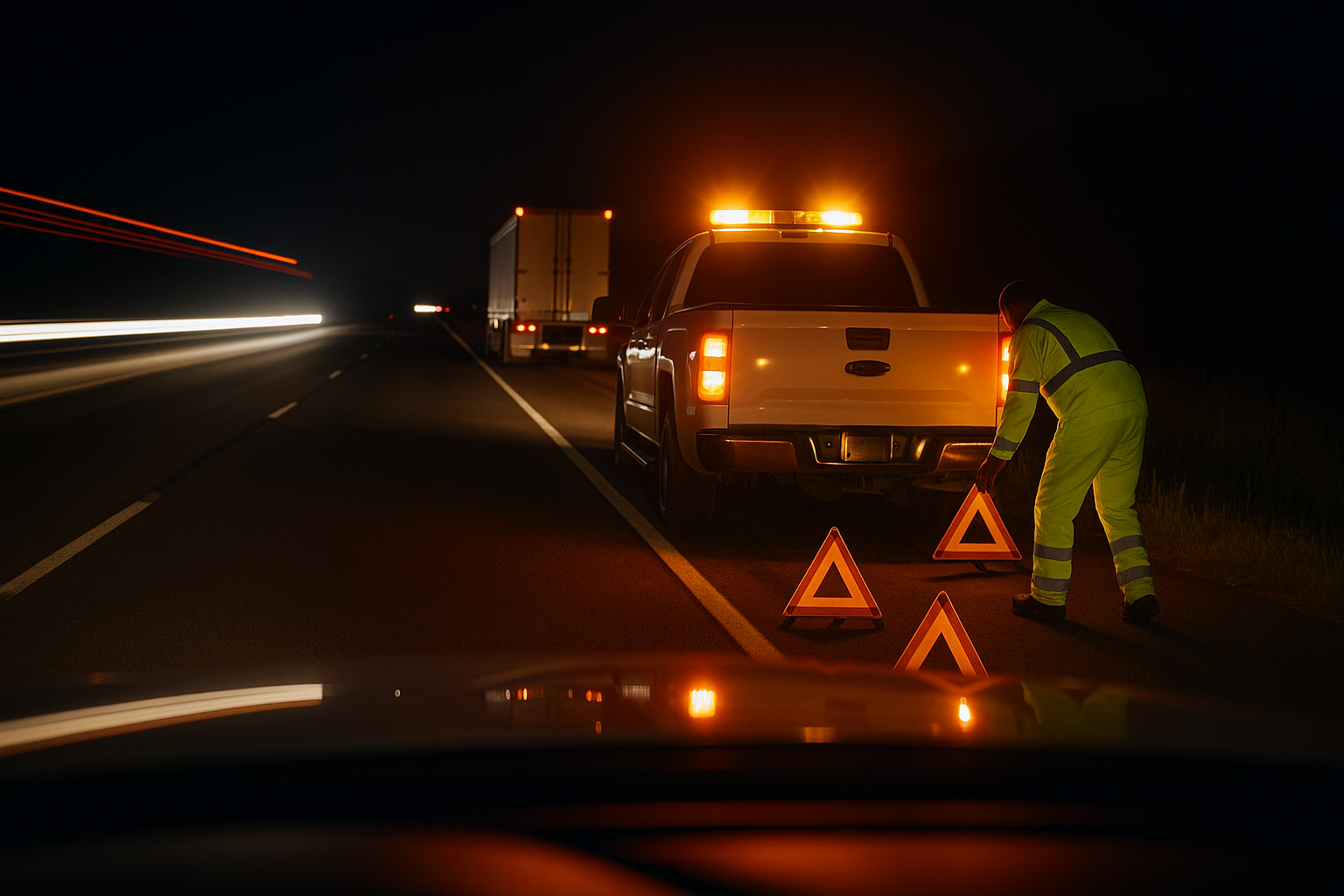Cones, Triangles, and Staying Visible at Night
This post may contain affiliate links, including Amazon links. As an Amazon Associate, we earn from qualifying purchases.
September 19, 2025 - Reading time: 29 minutes
Roadside technicians face their greatest danger from passing traffic. Learn how cones, triangles, flares, and hi-viz PPE keep you visible and alive during nighttime repairs.

The Most Dangerous Job Is Standing Still
When most people picture dangerous roadside work, they imagine crawling under a tractor’s axle or wrestling a tire off a rim. But for road technicians, the most life-threatening hazard often has nothing to do with tools or grease.
It’s the traffic flying past you at 70 miles per hour.
Every distracted driver staring at a phone, every drowsy commuter drifting over the line, every big rig hugging the shoulder they’re all potential killers if they don’t see you in time. And here’s the truth: on the shoulder, you’re invisible until you make yourself impossible to miss.
That’s where cones, triangles, reflective gear, and lighting come in. They aren’t accessories. They are your first line of defense.
This isn’t about compliance, and it isn’t about looking professional. It’s about staying alive when everything around you is designed to put you at risk.
Why Road Techs Get Hit: The Hazards You Can’t Ignore
Before we dive into best practices, let’s face the hazards head-on.
-
Distracted Drivers: Texting, fumbling with GPS, or simply not paying attention. Modern cars have more screens than cockpits and every one of them can take eyes off you.
-
Drowsy Drivers: Fatigue sets in, and shoulders become unintended rest stops. Studies show that a tired driver drifts more predictably than a drunk one.
-
Weather: Rain, fog, snow, and darkness eat light. Flashers alone often aren’t enough to pierce through it.
-
Partial Lane Blockage: If your service truck takes up part of the lane, you’re forcing traffic to swerve. Without warning, you’ve created a slalom course with you as the target cone.
-
Invisible Clothing: A black hoodie may be comfortable, but to oncoming headlights, it makes you disappear.
👉 For rookies: you don’t get to choose when or where a call happens. You may be on a blind curve, in freezing rain, or in a median. That means your survival depends on how quickly you can make yourself visible.
Step One: Position the Service Truck
Your truck is more than a toolbox on wheels it’s a barrier between you and traffic. Position it wisely.
Angle the Truck
-
Park with the nose slightly pointed toward traffic. This creates a visual cue and a buffer zone.
-
If struck, the truck deflects impact away from you, not into you.
Flashers and Strobes On
-
Never rely on hazard lights alone. Use strobes, beacons, and any auxiliary flashers. Movement and brightness draw attention faster than a steady blink.
Shoulder vs. Median
-
Always choose the right shoulder over the median if possible. Traffic is slower, and escape routes are easier.
-
The median is unpredictable: cars cross over, speeds are higher, and there’s less space to work.
👉 Rookie tip: When in doubt, ask yourself: “If this truck gets hit, where will the force go and will it take me with it?”
Step Two: Deploy Warning Devices
Warning devices are not optional. They’re required by law (FMCSA §392.22), but more importantly, they buy you seconds of reaction time from drivers and seconds mean life.
Reflective Triangles
-
Place three triangles behind the truck:
-
First at 100 feet,
-
Second at 200 feet,
-
Third at 300 feet.
-
On curves or hills, extend further if drivers can’t see the device until the last second, it’s useless.
Cones
-
Use in addition to triangles, especially in low visibility.
-
Reflective bands increase night performance.
-
Place near the truck to widen your buffer zone.
Flares
-
High visibility, but high risk. Never use near fuel spills, flammable cargo, or dry grass.
-
If safe, place in line with triangles to create a moving line of light that draws drivers’ eyes.
👉 Rookie tip: Don’t cluster devices near the truck. Spread them out. A triangle 20 feet behind your bumper might make you feel better, but to a driver at 65 mph, it’s nothing more than a speed bump.
Step Three: Wear High-Visibility PPE
Cones and triangles warn drivers, but your personal protection equipment (PPE) makes you visible.
-
Hi-Viz Vest/Jacket: Minimum Class 2 reflective striping; Class 3 if you’re in rain, snow, or heavy traffic.
-
Reflective Rain Gear: Dark raincoats are deadly water absorbs light, and headlights won’t catch you. Always carry a reflective raincoat in your truck.
-
Headlamp: Not just for seeing what you’re doing. Moving light on your head makes drivers’ eyes track you.
-
Gloves with Reflective Accents: Even your hands become signals when they catch the light.
👉 Imagine being a driver at night: a glowing triangle says “hazard ahead.” But a moving reflective stripe says “human being.” That’s what keeps them from drifting into your lane.
Step Four: Light the Work Zone
Never work in the dark. Period.
-
Portable LED Floodlights: Set them up to bathe the entire side of the truck in light.
-
Truck-Mounted Spotlights: Angle them down, not into oncoming traffic. Blinding drivers is just as dangerous as being invisible.
-
Headlamps: Keep a backup with spare batteries. Nothing screams “rookie mistake” like fumbling in the dark.
👉 Rookie tip: Shadows are blind spots. If you can’t see your own boots, a driver can’t see you either.
Real-World Story: The Near Miss in Tennessee
A road tech in Tennessee was changing a tire at night. He set out one cone, 20 feet behind his truck. He wore a dark hoodie and relied only on his truck’s hazard lights.
A car approached, clipped the cone, grazed the truck, and missed him by inches.
The driver later admitted he thought the flashing hazards were a car pulling onto the shoulder not a stopped service truck with a human being kneeling beside it.
Lesson: Cones close to the truck don’t protect you. Distance and reflection do.
Common Rookie Mistakes
One Cone Wonder
A single cone is not a warning system. Always set three triangles minimum.
Dark Clothing
Hoodies and jeans blend into shadows. Hi-viz is your armor.
Wrong Placement
Triangles too close to the truck give no reaction time.
On curves and hills, rookies forget to extend distance.
Complacency
Thinking “I’ll only be here five minutes.” Accidents happen in seconds, not minutes.
Call to Action: The End of Every Shift
Before you clock out tonight, ask yourself:
-
Do I have three reflective triangles in good shape?
-
Is my hi-viz vest clean, reflective, and within reach?
-
Do I carry a reflective raincoat?
-
Is my headlamp working, with spare batteries?
If any answer is no, fix it before the next call.
Visibility Is Survival
The first step in being a road tech isn’t knowing how to wrench it’s knowing how to stay alive long enough to wrench.
Cones, triangles, flares, hi-viz PPE, and lighting aren’t add-ons. They’re the tools that keep distracted drivers from turning a service call into a tragedy.
Takeaway: If they can’t see you, they can’t avoid you. Make yourself visible. Make yourself impossible to miss.
